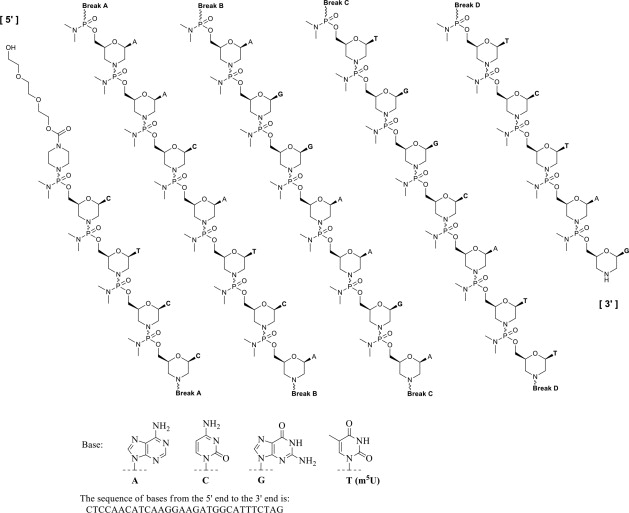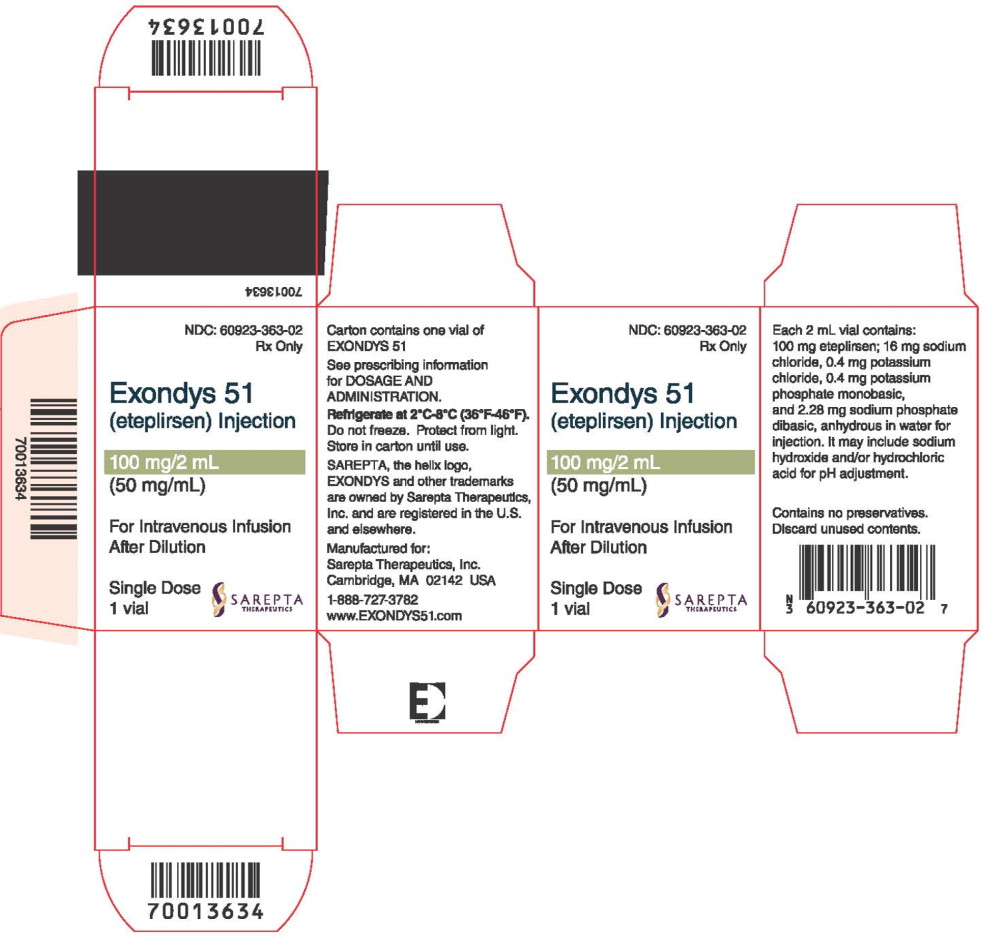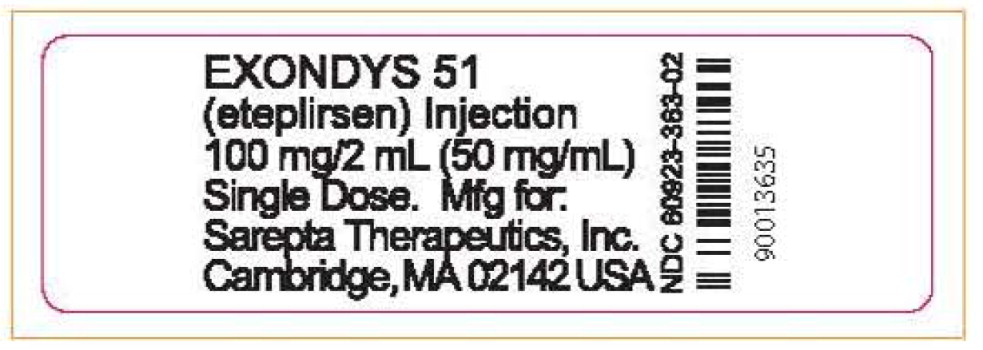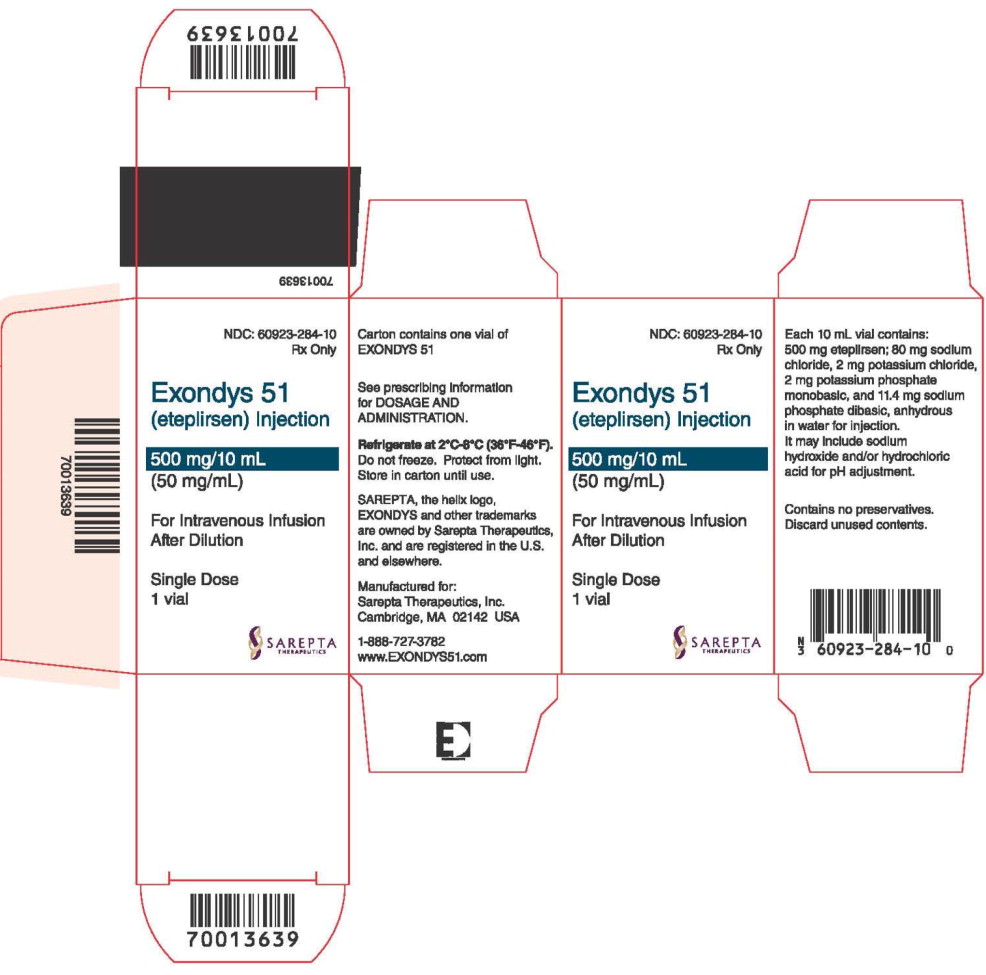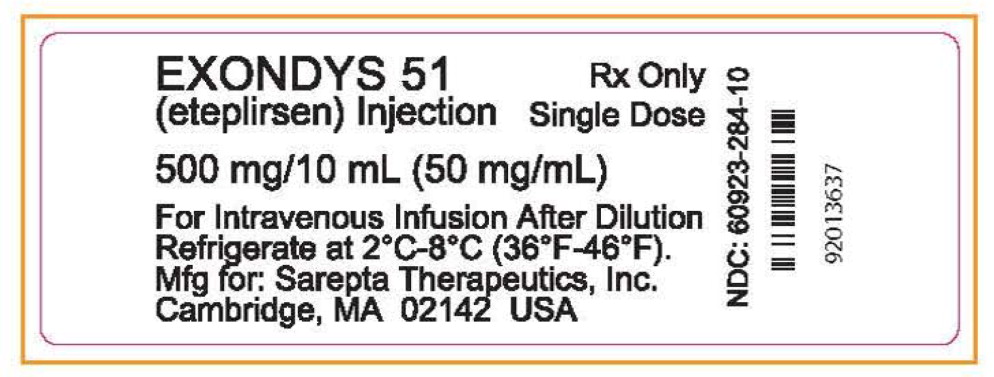EXONDYS 51- eteplirsen injection
Exondys 51 by
Drug Labeling and Warnings
Exondys 51 by is a Prescription medication manufactured, distributed, or labeled by Sarepta Therapeutics, Inc.. Drug facts, warnings, and ingredients follow.
Drug Details [pdf]
-
HIGHLIGHTS OF PRESCRIBING INFORMATION
These highlights do not include all the information needed to use EXONDYS 51 safely and effectively. See full prescribing information for EXONDYS 51.
EXONDYS 51 (eteplirsen) injection, for intravenous use
Initial U.S. Approval: 2016INDICATIONS AND USAGE
EXONDYS 51 is an antisense oligonucleotide indicated for the treatment of Duchenne muscular dystrophy (DMD) in patients who have a confirmed mutation of the DMD gene that is amenable to exon 51 skipping. This indication is approved under accelerated approval based on an increase in dystrophin in skeletal muscle observed in some patients treated with EXONDYS 51 [see Clinical Studies (14)]. A clinical benefit of EXONDYS 51 has not been established. Continued approval for this indication may be contingent upon verification of a clinical benefit in confirmatory trials. (1)
DOSAGE AND ADMINISTRATION
DOSAGE FORMS AND STRENGTHS
CONTRAINDICATIONS
None (4)
WARNINGS AND PRECAUTIONS
- Hypersensitivity Reactions: Hypersensitivity reactions, including pyrexia, flushing, cough, dyspnea, bronchospasm, rash, urticaria, and hypotension, have occurred in patients treated with EXONDYS 51. If hypersensitivity reactions occur, institute appropriate medical treatment and consider slowing the infusion or interrupting the EXONDYS 51 therapy. (2.3, 5.1)
ADVERSE REACTIONS
The most common adverse reactions (incidence ≥35% and higher than placebo) were balance disorder and vomiting (6.1)
To report SUSPECTED ADVERSE REACTIONS, contact Sarepta Therapeutics, Inc. at 1-888-SAREPTA (1-888-727-3782) or FDA at 1-800-FDA-1088 or www.fda.gov/medwatch.
See 17 for PATIENT COUNSELING INFORMATION.
Revised: 1/2020
-
Table of Contents
FULL PRESCRIBING INFORMATION: CONTENTS*
1 INDICATIONS AND USAGE
2 DOSAGE AND ADMINISTRATION
2.1 Dosing Information
2.2 Preparation Instructions
2.3 Administration Instructions
3 DOSAGE FORMS AND STRENGTHS
4 CONTRAINDICATIONS
5 WARNINGS AND PRECAUTIONS
5.1 Hypersensitivity Reactions
6 ADVERSE REACTIONS
6.1 Clinical Trials Experience
8 USE IN SPECIFIC POPULATIONS
8.1 Pregnancy
8.2 Lactation
8.4 Pediatric Use
8.5 Geriatric Use
8.6 Patients with Renal Impairment
10 OVERDOSAGE
11 DESCRIPTION
12 CLINICAL PHARMACOLOGY
12.1 Mechanism of Action
12.2 Pharmacodynamics
12.3 Pharmacokinetics
13 NONCLINICAL TOXICOLOGY
13.1 Carcinogenesis, Mutagenesis, Impairment of Fertility
14 CLINICAL STUDIES
16 HOW SUPPLIED/STORAGE AND HANDLING
16.1 How Supplied
16.2 Storage and Handling
17 PATIENT COUNSELING INFORMATION
- * Sections or subsections omitted from the full prescribing information are not listed.
-
1 INDICATIONS AND USAGE
EXONDYS 51 is indicated for the treatment of Duchenne muscular dystrophy (DMD) in patients who have a confirmed mutation of the DMD gene that is amenable to exon 51 skipping. This indication is approved under accelerated approval based on an increase in dystrophin in skeletal muscle observed in some patients treated with EXONDYS 51 [see Clinical Studies (14)]. A clinical benefit of EXONDYS 51 has not been established. Continued approval for this indication may be contingent upon verification of a clinical benefit in confirmatory trials.
-
2 DOSAGE AND ADMINISTRATION
2.1 Dosing Information
The recommended dose of EXONDYS 51 is 30 milligrams per kilogram administered once weekly as a 35 to 60 minute intravenous infusion.
If a dose of EXONDYS 51 is missed, it may be administered as soon as possible after the scheduled time.
2.2 Preparation Instructions
EXONDYS 51 is supplied in single-dose vials as a preservative-free concentrated solution that requires dilution prior to administration. Parenteral drug products should be inspected visually for particulate matter and discoloration prior to administration, whenever solution and container permit. Use aseptic technique.
- Calculate the total dose of EXONDYS 51 to be administered based on the patient's weight and the recommended dose of 30 milligrams per kilogram. Determine the volume of EXONDYS 51 needed and the correct number of vials to supply the full calculated dose.
- Allow vials to warm to room temperature. Mix the contents of each vial by gently inverting 2 or 3 times. Do not shake.
- Visually inspect each vial of EXONDYS 51. EXONDYS 51 is a clear, colorless solution that may have some opalescence. Do not use if the solution in the vials is discolored or particulate matter is present.
- With a syringe fitted with a 21-gauge or smaller non-coring needle, withdraw the calculated volume of EXONDYS 51 from the appropriate number of vials.
- Dilute the withdrawn EXONDYS 51 in 0.9% Sodium Chloride Injection, USP, to make a total volume of 100-150 mL. Visually inspect the diluted solution for particulates.
- EXONDYS 51 contains no preservatives and should be administered immediately after dilution. Complete infusion of diluted EXONDYS 51 solution within 4 hours of dilution. If immediate use is not possible, the diluted solution may be stored for up to 24 hours at 2ºC to 8ºC (36ºF to 46ºF). Do not freeze. Discard unused EXONDYS 51.
2.3 Administration Instructions
Application of a topical anesthetic cream to the infusion site prior to administration of EXONDYS 51 may be considered.
EXONDYS 51 is administered via intravenous infusion. Flush the intravenous access line with 0.9% Sodium Chloride Injection, USP, prior to and after infusion.
Infuse the diluted EXONDYS 51 solution over 35 to 60 minutes. Do not mix other medications with EXONDYS 51 or infuse other medications concomitantly via the same intravenous access line.
If a hypersensitivity reaction occurs, consider slowing the infusion or interrupting the EXONDYS 51 therapy [see Warnings and Precautions (5.1) and Adverse Reactions (6.1)].
- 3 DOSAGE FORMS AND STRENGTHS
- 4 CONTRAINDICATIONS
-
5 WARNINGS AND PRECAUTIONS
5.1 Hypersensitivity Reactions
Hypersensitivity reactions, including rash and urticaria, pyrexia, flushing, cough, dyspnea, bronchospasm, and hypotension, have occurred in patients who were treated with EXONDYS 51. If a hypersensitivity reaction occurs, institute appropriate medical treatment and consider slowing the infusion or interrupting the EXONDYS 51 therapy [see Dosage and Administration (2.3)].
-
6 ADVERSE REACTIONS
6.1 Clinical Trials Experience
Because clinical trials are conducted under widely varying conditions, adverse reaction rates observed in clinical trials of a drug cannot be directly compared to rates in the clinical trials of another drug and may not reflect the rates observed in practice.
In the EXONDYS 51 clinical development program, 107 patients received at least one intravenous dose of EXONDYS 51, ranging between 0.5 mg/kg (0.017 times the recommended dosage) and 50 mg/kg (1.7 times the recommended dosage). All patients were male and had genetically confirmed Duchenne muscular dystrophy. Age at study entry was 4 to 19 years. Most (89%) patients were Caucasian.
EXONDYS 51 was studied in a double-blind, placebo-controlled study for 24 weeks (Study 1), followed by an open label extension (Study 2). In Study 1, 12 patients were randomized to receive weekly intravenous infusions of EXONDYS 51 (n=8) or placebo (n=4) for 24 weeks. All 12 patients continued in Study 2 and received open-label EXONDYS 51 weekly for up to 208 weeks.
In Study 1, 4 patients received placebo, 4 patients received EXONDYS 51 30 mg/kg, and 4 patients received EXONDYS 51 50 mg/kg (1.7 times the recommended dosage). In Study 2, 6 patients received EXONDYS 51 30 mg/kg/week and 6 patients received EXONDYS 51 50 mg/kg/week [see Clinical Studies (14)].
Adverse reactions that occurred in 2 or more patients who received EXONDYS 51 and were more frequent than in the placebo group in Study 1 are presented in Table 1 (the 30 and 50 mg/kg groups are pooled). Because of the small numbers of patients, these represent crude frequencies that may not reflect the frequencies observed in practice. The 50 mg/kg once weekly dosing regimen of EXONDYS 51 is not recommended [see Dosage and Administration (2.1)].
The most common adverse reactions were balance disorder and vomiting.
Table 1. Adverse Reactions in DMD Patients Treated with 30 or 50 mg/kg/week1 EXONDYS 51 with Incidence at Least 25% More than Placebo (Study 1) 1 50 mg/kg/week = 1.7 times the recommended dosage
Adverse Reactions EXONDYS 51 (N=8) Placebo (N=4) % % Balance disorder 38 0 Vomiting 38 0 Contact dermatitis 25 0 In the 88 patients who received ≥30 mg/kg/week of EXONDYS 51 for up to 208 weeks in clinical studies, the following events were reported in ≥10% of patients and occurred more frequently than on the same dose in Study 1: vomiting, contusion, excoriation, arthralgia, rash, catheter site pain, and upper respiratory tract infection.
Hypersensitivity reactions have occurred in patients treated with EXONDYS 51 [see Warnings and Precautions (5.1)].
-
8 USE IN SPECIFIC POPULATIONS
8.2 Lactation
Risk Summary
There are no human or animal data to assess the effect of EXONDYS 51 on milk production, the presence of eteplirsen in milk, or the effects of EXONDYS 51 on the breastfed infant.
The developmental and health benefits of breastfeeding should be considered along with the mother's clinical need for EXONDYS 51 and any potential adverse effects on the breastfed infant from EXONDYS 51 or from the underlying maternal condition.
8.4 Pediatric Use
EXONDYS 51 is indicated for the treatment of Duchenne muscular dystrophy (DMD) in patients who have a confirmed mutation of the DMD gene that is amenable to exon 51 skipping, including pediatric patients [see Clinical Studies (14)].
Intravenous administration of eteplirsen (0, 100, 300, or 900 mg/kg) to juvenile male rats once weekly for 10 weeks beginning on postnatal day 14 resulted in renal tubular necrosis at the highest dose tested and decreased bone densitometry parameters (mineral density, mineral content, area) at all doses. The kidney findings were associated with clinical pathology changes (increased serum urea nitrogen and creatinine, decreased urine creatinine clearance). No effects were observed on the male reproductive system, neurobehavioral development, or immune function. An overall no-effect dose was not identified. Plasma eteplirsen exposure (AUC) at the lowest dose tested (100 mg/kg) was similar to that in humans at the recommended human dose (30 mg/kg).
8.5 Geriatric Use
DMD is largely a disease of children and young adults; therefore, there is no geriatric experience with EXONDYS 51.
8.6 Patients with Renal Impairment
Renal clearance of eteplirsen is reduced in non-DMD adults with renal impairment based on estimated creatinine clearance [see Clinical Pharmacology (12.3)]. However, because of the effect of reduced skeletal muscle mass on creatinine measurements in DMD patients, no specific dosage adjustment can be recommended for DMD patients with renal impairment.
- 10 OVERDOSAGE
-
11 DESCRIPTION
EXONDYS 51 (eteplirsen) injection is a sterile, aqueous, preservative-free, concentrated solution for dilution prior to intravenous administration. EXONDYS 51 is clear and colorless, and may have some opalescence. EXONDYS 51 is supplied in single dose vials containing 100 mg or 500 mg eteplirsen (50 mg/mL). EXONDYS 51 is formulated as an isotonic, phosphate buffered saline solution with an osmolality of 260 to 320 mOsm and a pH of 7.5. Each milliliter of EXONDYS 51 contains 50 mg eteplirsen; 0.2 mg potassium chloride, 0.2 mg potassium phosphate monobasic, 8 mg sodium chloride, and 1.14 mg sodium phosphate dibasic, anhydrous, in water for injection. The product may contain hydrochloric acid or sodium hydroxide to adjust pH.
Eteplirsen is an antisense oligonucleotide of the phosphorodiamidate morpholino oligomer (PMO) subclass. PMOs are synthetic molecules in which the five-membered ribofuranosyl rings found in natural DNA and RNA are replaced by a six-membered morpholino ring. Each morpholino ring is linked through an uncharged phosphorodiamidate moiety rather than the negatively charged phosphate linkage that is present in natural DNA and RNA. Each phosphorodiamidate morpholino subunit contains one of the heterocyclic bases found in DNA (adenine, cytosine, guanine, or thymine). Eteplirsen contains 30 linked subunits. The molecular formula of eteplirsen is C364H569N177O122P30 and the molecular weight is 10305.7 daltons.
The structure and base sequence of eteplirsen are:
-
12 CLINICAL PHARMACOLOGY
12.1 Mechanism of Action
Eteplirsen is designed to bind to exon 51 of dystrophin pre-mRNA, resulting in exclusion of this exon during mRNA processing in patients with genetic mutations that are amenable to exon 51 skipping. Exon skipping is intended to allow for production of an internally truncated dystrophin protein, which was evaluated in Study 2 and Study 3 [see Clinical Studies (14)].
12.2 Pharmacodynamics
All EXONDYS 51-treated patients evaluated (n=36) were found to produce messenger ribonucleic acid (mRNA) for a truncated dystrophin protein by reverse transcription polymerase chain reaction.
In Study 2, the average dystrophin protein level in muscle tissue after 180 weeks of treatment with EXONDYS 51 was 0.93% of normal (i.e., 0.93% of the dystrophin level in healthy subjects). Because of insufficient information on dystrophin protein levels before treatment with EXONDYS 51 in Study 1, it is not possible to estimate dystrophin production in response to EXONDYS 51 in Study 1.
In Study 3, the average dystrophin protein level was 0.16% of normal before treatment, and 0.44% of normal after 48 weeks of treatment with EXONDYS 51 [see Clinical Studies (14)]. The median increase in truncated dystrophin in Study 3 was 0.1% [see Clinical Studies (14)].
12.3 Pharmacokinetics
Following single or multiple intravenous infusions of EXONDYS 51 in male pediatric DMD patients, plasma concentration-time profiles of eteplirsen were generally similar and showed multi-phasic decline. The majority of drug elimination occurred within 24 hours. Approximate dose-proportionality and linearity in PK properties were observed following multiple-dose studies (0.5 mg/kg/week [0.017 times the recommended dosage] to 50 mg/kg/week [1.7 times the recommended dosage]). There was no significant drug accumulation following weekly dosing across this dose range. The inter-subject variability for eteplirsen Cmax and AUC range from 20 to 55%.
Following single or multiple intravenous infusions of EXONDYS 51, the peak plasma concentrations (Cmax) of eteplirsen occurred near the end of infusion (i.e., 1.1 to 1.2 hours across a dose range of 0.5 mg/kg/week to 50 mg/kg/week).
Distribution
In vitro investigation suggested that plasma protein binding of eteplirsen in human ranges between 6 to 17%. The mean apparent volume of distribution (Vss) of eteplirsen was 600 mL/kg following weekly intravenous infusion of EXONDYS 51 at 30 mg/kg.
Twenty-four hours after the end of the infusion, mean concentrations of eteplirsen were 0.07% of Cmax. Accumulation of eteplirsen during once weekly dosing has not been observed.
Elimination
The total clearance of eteplirsen was 339 mL/hr/kg following 12 weeks of therapy with 30 mg/kg/week.
Metabolism
Eteplirsen did not appear to be metabolized by hepatic microsomes of any species tested, including humans.
Excretion
Renal clearance of eteplirsen accounts for approximately two-thirds of the administered dose within 24 hours of intravenous administration. Elimination half-life (t1/2) of eteplirsen was 3 to 4 hours.
Specific Populations
Age:
The pharmacokinetics of eteplirsen have been evaluated in male pediatric DMD patients. There is no experience with the use of EXONDYS 51 in patients 65 years of age or older.
Patients with Renal Impairment:
The effect of renal impairment on the pharmacokinetics of eteplirsen was evaluated in non-DMD subjects aged 51 to 75 years with mild (n=8, creatinine clearance ≥60 mL/min and <90 mL/min) or moderate (n=8, creatinine clearance ≥30 mL/min and <60 mL/min) renal impairment and matched healthy subjects (n=9, creatinine clearance >90 mL/min). Subjects received a single 30 mg/kg intravenous dose of eteplirsen.
Subjects with mild and moderate renal impairment showed higher eteplirsen exposure compared to subjects with normal renal function. In subjects with mild and moderate renal impairment, exposure (AUC) increased approximately 1.4-fold and 2.4-fold, respectively. The effect of severe renal impairment or end-stage renal disease on eteplirsen pharmacokinetics and safety has not been studied.
Estimated creatinine clearance values derived from the Cockcroft-Gault equation and the threshold definitions for mild, moderate, and severe renal impairment in otherwise healthy adults would not be generalizable to patients with DMD. Therefore, no specific dosage adjustment can be recommended for patients with renal impairment.
Drug Interaction Studies
In vitro data showed that eteplirsen did not significantly inhibit CYP1A2, CYP2B6, CYP2C8, CYP2C9, CYP2C19, CYP2D6, or CYP3A4/5. Eteplirsen did not induce CYP2B6 or CYP3A4, and induction of CYP1A2 was substantially less than the prototypical inducer, omeprazole. Eteplirsen was not a substrate nor did it have any major inhibitory potential for any of the key human transporters tested (OAT1, OAT3, OCT1, OCT2, OATP1B1, OATP1B3, P-gp, BCRP, MRP2 and BSEP). Based on in vitro data on plasma protein binding, CYP or drug transporter interactions, and microsomal metabolism, eteplirsen is expected to have a low potential for drug-drug interactions in humans.
-
13 NONCLINICAL TOXICOLOGY
13.1 Carcinogenesis, Mutagenesis, Impairment of Fertility
Mutagenesis
Eteplirsen was negative in in vitro (bacterial reverse mutation and chromosomal aberration in CHO cells) and in vivo (mouse bone marrow micronucleus) assays.
Impairment of Fertility
Fertility studies in animals were not conducted with eteplirsen. No effects on the male reproductive system were observed following intravenous administration of eteplirsen (0, 5, 40, or 320 mg/kg) to male monkeys once weekly for 39 weeks. Plasma eteplirsen exposure (AUC) in monkeys at the highest dose tested was 20 times that in humans at recommended human dose (30 mg/kg).
-
14 CLINICAL STUDIES
EXONDYS 51 was evaluated in three clinical studies in patients who have a confirmed mutation of the DMD gene that is amenable to exon 51 skipping.
In Study 1, patients were randomized to receive weekly infusions of EXONDYS 51 (30 mg/kg, n=4); EXONDYS 51 (50 mg/kg, n=4), or placebo (n=4) for 24 weeks. The primary endpoint was dystrophin production; a clinical outcome measure, the 6-minute walk test (6MWT), was also assessed. The 6MWT measures the distance that a patient can walk on a flat, hard surface in a period of 6 minutes. Patients had a mean age of 9.4 years, a mean 6-minute walk distance (6MWD) at baseline of 363 meters, and were on a stable dose of corticosteroids for at least 6 months. There was no significant difference in change in 6MWD between patients treated with EXONDYS 51 and those treated with placebo.
All 12 patients who participated in Study 1 continued treatment with open-label EXONDYS 51 weekly for an additional 4 years in Study 2. The 4 patients who had been randomized to placebo were re-randomized 1:1 to EXONDYS 51 30 or 50 mg/kg/week such that there were 6 patients on each dose. Patients who participated in Study 2 were compared to an external control group. The primary clinical efficacy outcome measure was the 6MWT. Eleven patients in Study 2 had a muscle biopsy after 180 weeks of treatment with EXONDYS 51, which was analyzed for dystrophin protein level by Western blot. Study 2 failed to provide evidence of a clinical benefit of EXONDYS 51 compared to the external control group. The average dystrophin protein level after 180 weeks of treatment with EXONDYS 51 was 0.93% of the dystrophin level in healthy subjects. Because of insufficient information on dystrophin protein levels before treatment with EXONDYS 51 in Study 1, it is not possible to estimate dystrophin production in response to EXONDYS 51 in Study 1.
In Study 3, 13 patients were treated with open-label EXONDYS 51 (30 mg/kg) weekly for 48 weeks and had a muscle biopsy at baseline and after 48 weeks of treatment. Patients had a mean age of 8.9 years and were on a stable dose of corticosteroids for at least 6 months. Dystrophin levels in muscle tissue were assessed by Western blot. In the 12 patients with evaluable results, the pre-treatment dystrophin level was 0.16% ± 0.12% (mean ± standard deviation) of the dystrophin level in a healthy subject and 0.44% ± 0.43% after 48 weeks of treatment with EXONDYS 51 (p < 0.05). The median increase after 48 weeks was 0.1%.
Individual patient dystrophin levels from Study 3 are shown in Table 2.
Table 2. Western Blot Results: EXONDYS 51-Treated (Week 48) vs Pre-treatment Baseline (% Normal Dystrophin) (Study 301) Patient Number Baseline
% normal dystrophinWeek 48
% normal dystrophinChange from Baseline
% normal dystrophin1 0.13 0.26 0.13 2 0.35 0.36 0.01 3 0.06 0.37 0.31 4 0.04 0.10 0.06 5 0.17 1.02 0.85 6 0.37 0.30 -0.07 7 0.17 0.42 0.25 8 0.24 1.57 1.33 9 0.11 0.12 0.01 10 0.05 0.47 0.43 11 0.02 0.09 0.07 12 0.18 0.21 0.03 Mean 0.16 0.44 0.28; p=0.008 -
16 HOW SUPPLIED/STORAGE AND HANDLING
16.1 How Supplied
EXONDYS 51 injection is supplied in single-dose vials. The solution is clear and colorless, and may have some opalescence.
- Single-dose vials containing 100 mg/2 mL (50 mg/mL) eteplirsen
NDC: 60923-363-02 - Single-dose vials containing 500 mg/10 mL (50 mg/mL) eteplirsen
NDC: 60923-284-10 -
17 PATIENT COUNSELING INFORMATION
Hypersensitivity Reactions
Advise patients and/or caregivers that symptoms of hypersensitivity, including bronchospasm and hypotension, can occur with EXONDYS 51. Instruct them to seek immediate medical care should they experience signs and symptoms of hypersensitivity [see Warnings and Precautions (5.1)].
Manufactured for:
Sarepta Therapeutics, Inc.
Cambridge, MA 02142 USASAREPTA, SAREPTA THERAPEUTICS, EXONDYS, EXONDYS 51, and the EXONDYS 51 Logo are trademarks of Sarepta Therapeutics, Inc. registered in the U.S. Patent and Trademark Office and may be registered in various other jurisdictions.
-
PRINCIPAL DISPLAY PANEL
Principal Display Panel – Carton Label
NDC: 60923-363-02
Rx Only
Exondys 51
(eteplirsen) Injection100 mg/2 mL
(50 mg/mL)
For Intravenous Infusion
After Dilution
Single Dose
1 vial
SAREPTA
THERAPEUTICS -
PRINCIPAL DISPLAY PANEL
Principal Display Panel – Vial Label
NDC: 60923-363-02
EXONDYS 51
(eterplirsen) Injection100 mg/2 mL (50 mg/mL)
Single Dose. Mfg for:
Sarepta Therapeutics, Inc.
Cambridge, MA 02142 USA
-
PRINCIPAL DISPLAY PANEL
Principal Display Panel – Carton Label
NDC: 60923-284-10
Rx Only
Exondys 51
(eteplirsen) Injection500 mg/10 mL
(50 mg/mL)
For Intravenous Infusion
After Dilution
Single Dose
1 vial
SAREPTA
THERAPEUTICS -
PRINCIPAL DISPLAY PANEL
Principal Display Panel – Vial Label
NDC: 60923-284-10
EXONDYS 51
(eterplirsen) Injection500 mg/10 mL (50 mg/mL)
For Intravenous Infusion After Dilution
Refrigerate at 2°C-8°C (36°F-46°F).
Mfg for: Sarepta Therapeutics, Inc.
Cambridge, MA 02142 USA
-
INGREDIENTS AND APPEARANCE
EXONDYS 51
eteplirsen injectionProduct Information Product Type HUMAN PRESCRIPTION DRUG Item Code (Source) NDC: 60923-363 Route of Administration INTRAVENOUS Active Ingredient/Active Moiety Ingredient Name Basis of Strength Strength eteplirsen (UNII: AIW6036FAS) (eteplirsen - UNII:AIW6036FAS) eteplirsen 50 mg in 1 mL Inactive Ingredients Ingredient Name Strength sodium chloride (UNII: 451W47IQ8X) potassium chloride (UNII: 660YQ98I10) potassium phosphate, monobasic (UNII: 4J9FJ0HL51) sodium phosphate, dibasic, anhydrous (UNII: 22ADO53M6F) sodium hydroxide (UNII: 55X04QC32I) hydrochloric acid (UNII: QTT17582CB) water (UNII: 059QF0KO0R) Packaging # Item Code Package Description Marketing Start Date Marketing End Date 1 NDC: 60923-363-02 1 in 1 CARTON 09/19/2016 1 2 mL in 1 VIAL, SINGLE-USE; Type 0: Not a Combination Product Marketing Information Marketing Category Application Number or Monograph Citation Marketing Start Date Marketing End Date NDA NDA206488 09/19/2016 EXONDYS 51
eteplirsen injectionProduct Information Product Type HUMAN PRESCRIPTION DRUG Item Code (Source) NDC: 60923-284 Route of Administration INTRAVENOUS Active Ingredient/Active Moiety Ingredient Name Basis of Strength Strength eteplirsen (UNII: AIW6036FAS) (eteplirsen - UNII:AIW6036FAS) eteplirsen 50 mg in 1 mL Inactive Ingredients Ingredient Name Strength sodium chloride (UNII: 451W47IQ8X) potassium chloride (UNII: 660YQ98I10) potassium phosphate, monobasic (UNII: 4J9FJ0HL51) sodium phosphate, dibasic, anhydrous (UNII: 22ADO53M6F) sodium hydroxide (UNII: 55X04QC32I) hydrochloric acid (UNII: QTT17582CB) water (UNII: 059QF0KO0R) Packaging # Item Code Package Description Marketing Start Date Marketing End Date 1 NDC: 60923-284-10 1 in 1 CARTON 09/19/2016 1 10 mL in 1 VIAL, SINGLE-USE; Type 0: Not a Combination Product Marketing Information Marketing Category Application Number or Monograph Citation Marketing Start Date Marketing End Date NDA NDA206488 09/19/2016 Labeler - Sarepta Therapeutics, Inc. (121653406)
Trademark Results [Exondys 51]
Mark Image Registration | Serial | Company Trademark Application Date |
|---|---|
 EXONDYS 51 86876376 5134619 Live/Registered |
Sarepta Therapeutics, Inc. 2016-01-15 |
© 2025 FDA.report
This site is not affiliated with or endorsed by the FDA.
